The Relationship between Rights and Dance
An Interview with Wonyoung Kim
BY EMMALY WIEDERHOLT AND SOO JUNG BAE
Translated by Soo Jung Bae, Photos courtesy Wonyoung Kim
Wonyoung Kim is a dancer, actor, writer, and lawyer in South Korea. Here, he discusses how his two pieces, Love and Friendship Equality Act and Becoming-Dancer, problematize conceptions of the disabled body. He also explores his own bias toward the aesthetics of disability and how he likens choreography to law.
Note: This essay was first published in Stance on Dance’s spring/summer 2023 print issue. To learn more, visit stanceondance.com/print-publication.
한글로 인터뷰를 읽으시길 원하신다면 스크롤을 내려주세요.
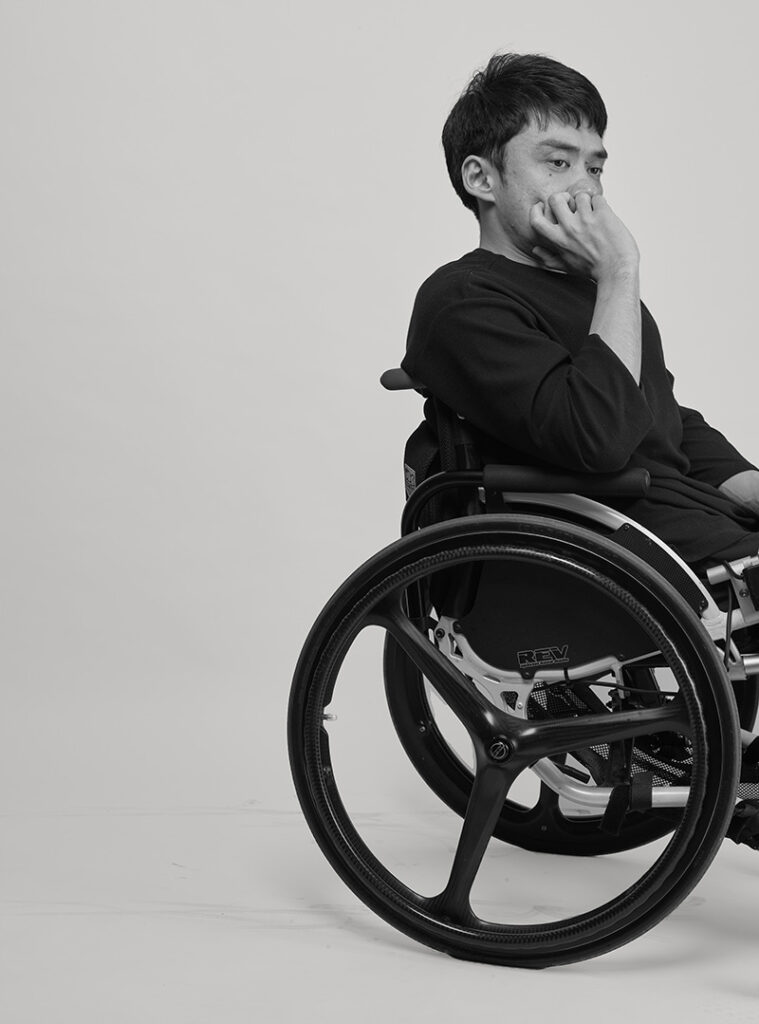
~~
How did you get into dance?
I participated in a play in middle school. Ever since then, I wanted to be onstage. After entering college, I wanted to do theater, but in college there was an active disability rights movement at that time in Korea. I had no time for theater. Later, I made a theater team for myself and did performances. More than narrative-based performances, I wanted performance that centered on movement and the body. At that time, I wasn’t sure if I could call that dance.
Then in 2016, I had a chance to participate in a workshop with the Korea International Accessible Dance Festival. Since then, it slowly dawned on me that I could name my projects dance. I have been focusing on dance projects for four years.
Why were you specifically interested in the body?
The easy answer would be because I have a disability. Even when I was in school, on the one hand, I was interested in the rights of the disabled and issues of discrimination, and on the other hand, I wanted to face the perspective on my body and the labels given to my body, like the social stigma on my body, my biological pain, and my feelings of inferiority.
When I was in college, I couldn’t share my lived body experience with my colleagues who were trying to change society. Most of them were non-disabled, and their concern was focused on the social structure. They seemed to believe that all problems – including my physiological or psychological pain, emotional turbulence, etc. – about disability could be solved by reforming the structure. Of course, I agreed with them. It is an issue related to social structures, but I wanted to say more than just that. Interest in somatic struggle brought my attention to theatrical work.
What was the inspiration and creative process behind your 2019 piece Love and Friendship Equality Act?
I got a suggestion from the Seoul Marginal Theatre Festival to create a performance. There’s this socially constructed idea of disability and at the same time there are the problems of my literal lived experiences of disability. I wanted to deal with my physical experiences. I wrote a play based on these ideas, but I wanted a more choreographic rather than a theatrical approach. So although the piece has a script, it’s more focused on dance.
The starting point of this work is the Disability Discrimination Act in Korea, similar to the Americans with Disabilities Act in the States. The play starts by explaining the law to the audience, but there’s a twist. It’s not actually a disability act but rather another law that does not exist. I made it up: the Love and Friendship Equality Act. The beginning half of the performance explains this nonexisting law to the audience. In the later half, the actor opens himself up and meets the audience, regardless of the law. I thought about how I could do that. After thinking about it for a while, I decided to take off my outer garments and wear a minimum amount of clothing so my body reveals its shape, and then to get off my wheelchair and onto the floor.
I needed to meet the audience as a physical being without all the talk about laws and norms. That’s how I decided to get out of my wheelchair. And I took off my outer clothes to reveal the shape of my body. I always camouflage my body by using big, long pants and thick books so that I could dignify myself. I wanted to look more like a lawyer. I would talk about my identity as a disabled person and would say that it’s something I am proud of. But at the same time, I’ve been hiding my body. That performance was an opportunity for me to break free of that paradox.
The decision to get off my wheelchair was something I hadn’t tried in any of my previous performances or even in daily life. When I’m around people, I could never imagine getting out of my wheelchair. But I thought I could truly meet the audience as a physical being that way.
I felt very vulnerable, even ashamed. But after getting off the wheelchair, I felt free. In my early teens, I always danced on the floor in my parents’ house. I was alone for the daytime after my family went out.
During that time, I danced and played basketball on the floor, crawling. I knew I was a good dancer on the floor, but at the same time, I couldn’t dance because of social norms. I broke that wall; when I got off the wheelchair and on the floor, I felt free, like I became a true dancer.
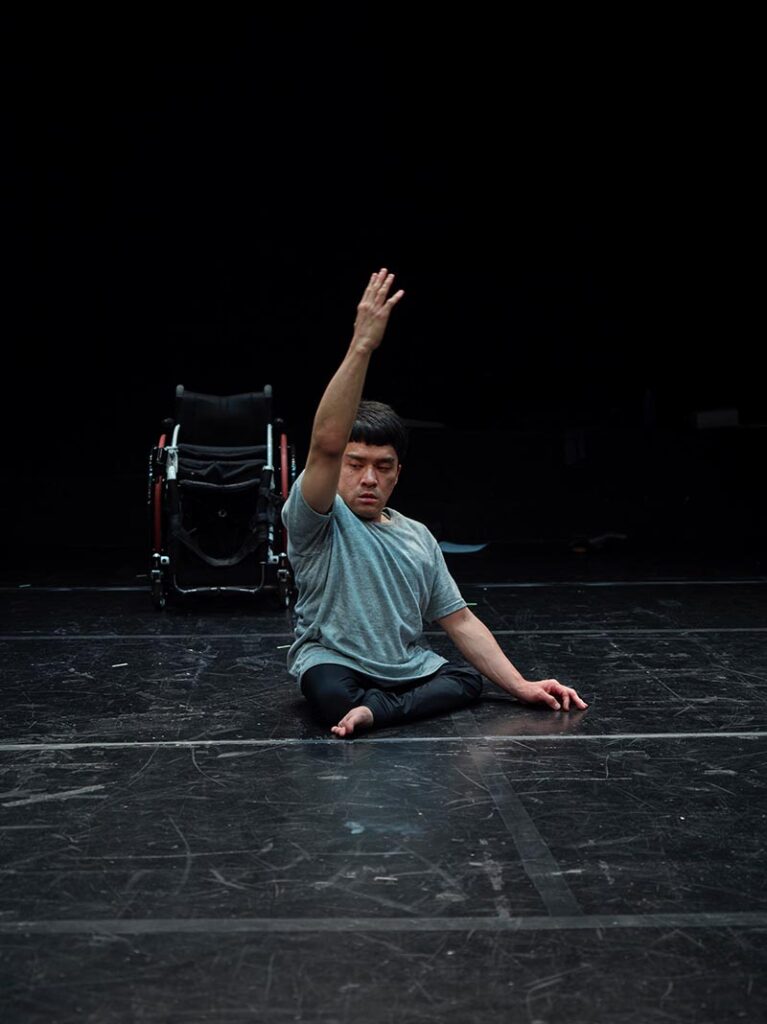
What was the inspiration and creative process behind your 2021 piece Becoming-Dancer?
In the contemporary dance scene in the 1960s, choreographers claimed that all bodies can dance, but in reality, disabled bodies were not represented. So we modified Trio A by Yvonne Rainer, who is an American contemporary dancer known to have revolutionized contemporary dance. We customized her piece so that I could perform it in my wheelchair with a non-disabled dancer.
There’s a clip of Trio A by Yvonne Rainer where she does daily movements. I cannot do those movements. But we “translated” that into movements I could do in my wheelchair. We translated the choreography twice: It was first customized to my body, and then it was translated one more time so that the non-disabled dancer could perform the once-modified version.
There are three choreographic sequences in the piece. We modified Trio A, so there’s that part. Then in the middle there’s a short solo, and in the end there’s a floor scene. In the floor scene, I had the chance to explore different movements that were possible for my body. In Love and Friendship Equality Act, it was the first time I got out of my wheelchair. But in this piece, I was able to expand my possible movements.
In Love and Friendship Equality Act, more than the choreography, it was important to get out of my wheelchair and meet the audience. But in Becoming-Dancer, it was more like a traditional dance where I figure out possible movements that are doable for my body and practice thoroughly. And through that kind of work, I was able to find what I could do. That was fun for me.
At the Korea International Accessible Dance Festival symposium in November 2022, you posed the question: How can we integrate our bodies into performances without obsessing over non-disability aesthetics? Can you share more of your thoughts on this question – what are non-disability aesthetics and how do they pose a problem for integrating dancers with disabilities?
Non-disability aesthetics is a broad concept with various definitions, but I focus on the body of the non-disabled dancer: asymmetrical, capable of using both arms and legs, a body that can walk and run. When non-disabled bodies are dancing onstage, there’s a certain satisfaction and beauty in those bodies. Personally, I think I’m not capable of letting go of that obsession toward non-disabled aesthetics. This disturbs the integration of disabled bodies into the dance world, both for me and for other disabled dancers.
To put it simply, I still cannot find different aesthetic moments in severely disabled bodies. I try to find it, but it’s not easy to meet that moment. In workshops, for instance, I meet a lot of dancers with different bodies, like a disabled ballet dancer, or a performer with cerebral palsy. I always try to find different and unique beauty, aesthetic, and value in each body, but I often fail. I want to break my perception, but it’s not easy for me. I feel like this is my limitation as a disabled dancer/choreographer.
If you personally are struggling to find equality in aesthetics between dancers with and without disabilities, how can we expect mainstream audiences to appreciate disability in dance?
I fail to capture the unique aesthetic, value, and beauty that exists in each body. But since I’m struggling with that, I share my frustration. Although I’m failing, there are many Korean audiences – and I’m sure there are audiences abroad too – who are capable of capturing the value and beauty of different bodies. The audiences whom I have met are capable of doing it and are better at it than I expected. So although I’m failing, I believe there’s possibility for the disabled to be integrated into mainstream dance.
How can we develop an aesthetic rooted in disability that doesn’t try to emulate non-disabled dance?
It’s a challenge for the dance world. I don’t have a clear answer. But for the disabled dancer to not just copy the movements of non-disabled dancers and find their own unique movements based on the characteristics of their body, it is important for the dancer’s body to be vivid. The more vivid the body is, the aesthetic power of that movement and shape becomes less important. (Think of Rilke’s poem Archaic Torso of Apollo that sang overwhelmingly of clarity after seeing Rodin’s sculptures.)
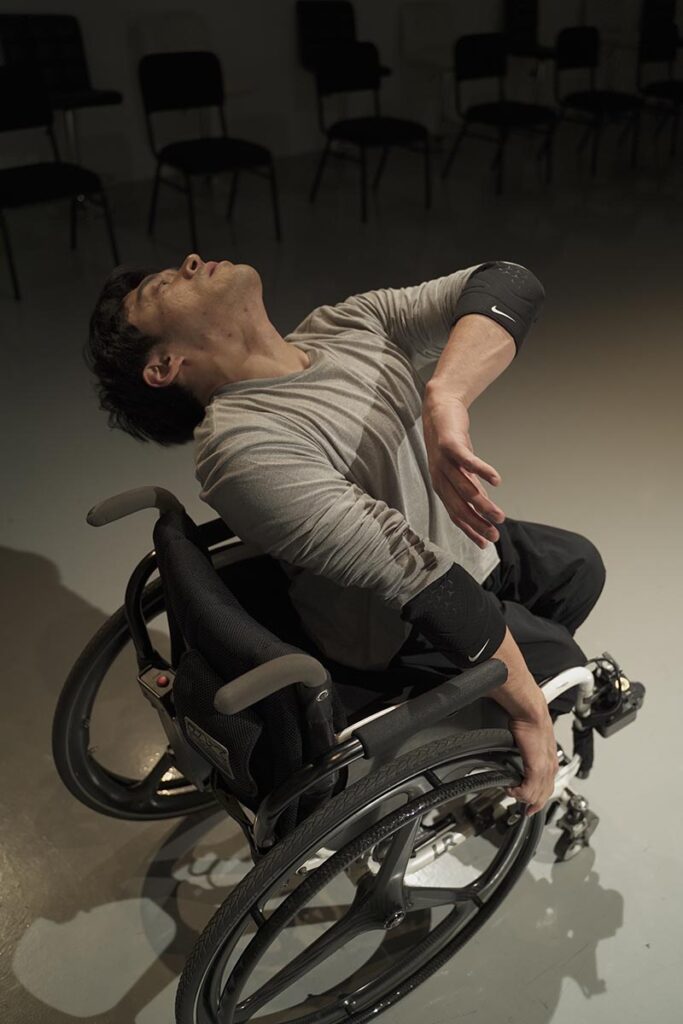
Another question you posed at the KIADA symposium was: What is the relationship between rights and dance? I understand you have a law degree. From your perspective, how does the law intersect with dance?
There’s a theme of how to create better laws, systems, and rights for diverse bodies to participate in creative activities. What I’m more interested in is not the matter of establishing better laws. Law is like choreography. There’s a similarity between these two. They give orders and create rules: “move in this way” or “this will be better.” When there’s specific choreography, it is harder, especially for disabled bodies, to perform the movements. There’s a chance that the disabled body cannot truly perform the choreography.
Roughly speaking, we can compare choreography to the legal system, and dance to democratic political actions. In terms of disabled bodies, I believe these two issues are deeply intertwined. Making a dance is like making a law. Sometimes I hate the law. I don’t want to choreograph. I just want to dance in an improvisational way. But is improvisation always good? No, I don’t think so. Improvisation sometimes makes me a bad performer.
It’s a political question. How can legal norms, a set of orders, enhance the freedom of diverse people? What kind of system is the best in creating a society that includes diverse people? This is also an artistic question for the different bodies that are performing any given choreography. It’s asking whether we need choreography and how we are going to perform that choreography.
Do you believe there are adequate opportunities for dancers with disabilities in South Korea? If not, what areas would you specifically like to see addressed?
If I had a magic wand, I would want every foreign dancer to speak Korean, or I would want every Korean disabled dancer to speak English or other foreign languages. Cooperation is very important, especially for disability dance. The Korean peninsula is like an island and our language is isolated. I know some very good artists in Korea, but they don’t have many opportunities to meet other performers around the world. I really want to make more opportunities for Korean performers to collaborate with performers in the US, Europe, or East Asia.
What’s next for you? Do you have an upcoming project or focus you’d like to share more about?
I will publish a book about performance and disability this coming summer. I will also go to Croatia and Slovenia this coming summer to perform Becoming-Dancer in festivals in two countries and four cities.
~~
Soo Jung Bae graduated from Ewha Womans University, majoring in International Studies and East Asian Studies. She wrote a picture book, Learning How to Be Together – Stories of Children with Developmental Disorders for the Non-Disabled, with Ji Yoon Seo-Mun, which describes behaviors of children with developmental disorders in the format of a cartoon, so that it is easier for the non-disabled to understand how children with developmental disorders behave. Soo Jung has engaged in multiple programs and projects that pursue international cooperation, and hopes to use her interest in East Asian philosophy in her future career.
~~
권리와 춤의 관계
김원영 무용수와의 인터뷰
에말리 위더홀트(Emmaly Wiederholt) 작성
배수정 번역
김원영 무용수는 한국의 무용수이자 배우, 작가, 변호사입니다. 본 인터뷰에는 그의 작품 사랑과 우정에서의 차별금지 및 권리구제에 관한 법률과 무용수-되기에 대한 이야기와 장애를 가진 몸에 대한 문제의식이 실려있습니다. 또, 비장애미학에 대한 스스로의 편견을 탐구한 내용과 안무와 법의 비유가 담겨 있습니다.
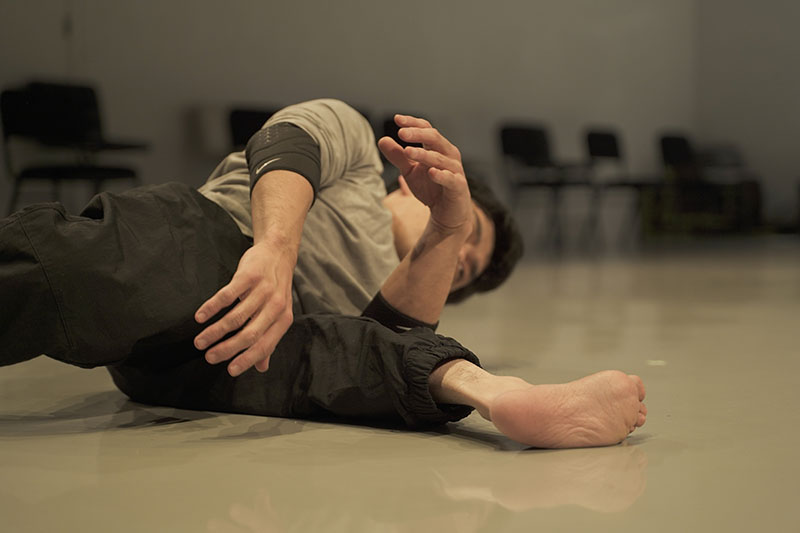
~~
어떻게 무용을 시작하게 되셨나요?
중학생 때 연극을 했고, 그 뒤로 무대에 오르고 싶었습니다. 대학에 입학해서 연극을 하고 싶었지만 당시 한국은 장애인인권운동이 활발했고, 대학에서 특히 뜨거웠기에 다른 활동에 대해 생각을 하기가 어려웠습니다. 뒤늦게 로스쿨 생활을 하면서 잠시 프로젝트 극단을 만들었고 그 후로 연극팀을 운영했습니다. 그 당시에도 저는 어떤 서사나 분명한 내러티브가 있는 공연이 아니라, 신체와 움직임이 중심이 된 형식의 공연에 관심이 있었습니다. 다만 당시에는 그것을 무용이라고 부르지는 못했습니다. 장애인들의 움직임을 무용이라고 부를 수 있는지 확신이 들지 않았습니다. 이후 한국에서 장애무용작품들을 접하고, 2016년 대한민국장애인국제무용제(KIADA) 무용 워크숍에 참여하면서 제가 하고 싶은 작업을 무용이라고 칭해도 좋다는 생각이 들었습니다. 무용작업에 집중한 것은 4년 정도 전부터입니다.
특별히 신체에 관심이 있었던 이유가 있을까요?
쉬운 답은 당연히 장애가 있기 때문이겠죠. 학교를 다닐 때도 그렇고, 저에게는 장애인의 권리와 차별 문제도 중요하지만, 다른 한편으로는 저의 신체에 부여된 낙인과 열등감, 육체적 고통, 그리고 제 몸을 바라보는 저의 시각 또한 문제였어요. 그것을 정면으로 마주하고 싶었던 것 같습니다. 그게 가장 기본적인 것 같아요.
대학교에 다닐 때, 제 몸이 겪는 경험을 친구들과 공유할 수 없었어요. 친구들은 사회를 바꾸고 싶어 했던 사람들이었거든요. 친구들 대부분은 장애를 갖고 있지 않았고, 또 동시에 사회 구조에 관심을 갖고 변화를 이끌어내고 싶어했어요. 친구들은 장애와 관련된 제 생리학적이고 정신적인 고통, 감정적인 변동을 포함한 모든 문제들이 사회 구조의 변혁을 통해 해결될 수 있다고 믿었어요. 물론 친구들의 의견에 동의하죠. 사회의 구조적인 문제가 존재해요. 하지만 저는 거기서 더 나아가고 싶었어요. 신체적인 고민에 대한 관심이 공연 작업에 대한 관심으로 옮겨간 것 같아요.
2019년도 작품 사랑과 우정에서의 차별금지 및 권리구제에 관한 법률을 창작하게 되신 계기와 창작 과정에 대해 설명해주실 수 있나요?
이 작업을 만든 것도 방금 얘기했던 저의 경험과 관련된 건데요, 일단 이 작업은 서울변방연극제에서 제안을 받아 공연을 만들게 되었습니다. 어떤 공연을 만들까 고민을 하다가 제가 오랫동안 가져왔던 문제의식을 다뤄보고 싶었어요. 세상에 우리가 바꿔야 될 사회적인 문제로서의 장애가 있고, 그것과 별개로 제 몸이 실제로 경험하고 느끼는 장애가 존재하죠. 이런 저의 신체적인 경험을 이야기하고 싶었어요. 이러한 주제로 공연을 구성했지만, 이걸 다루기 위해서는 연극적인 접근보다 무용적인 방식이 필요하다고 생각했어요. 그래서 이 작업은 대사가 있기는 하지만 훨씬 더 무용적인 작업이었어요.
이 작업의 시작은 한국의 장애인차별금지법인데요, 이 법을 관객들에게 설명하는 것으로 진행이 돼요. 그런데 이 법과 똑같은 건 아니고, 이 법을 바꿔서 우정과 사랑의 영역에서의 차별금지라고 하는, 실제로 존재하지 않는 법의 내용을 설명하는 전반부가 있어요. 후반부에서는 그 법을 설명하는 배우가 완전히 법과 무관하게, 자신의 신체를 오픈하고 관객을 만나는 것이 필요했어요. 어떻게 그걸 할 수 있을까 고민을 했어요. 그래서 제가 입고 있던 겉옷들을 다 벗고, 몸을 가장 잘 드러내는 옷만 입고, 휠체어 바닥에 내려오는 결정을 했어요.
법이나 규범들에 대한 이야기 없이 관객을 신체를 가진 존재로 만나는 것이 필요했어요. 그걸 어떻게 할까 고민을 했고, 휠체어에서 내려오는 걸졍을 했죠. 그리고 제가 입고 있던 겉옷들을 최대한 벗고, 몸이 잘 드러나는 옷만 입고 바닥에 내려왔어요. 저는 항상 길고 큰 바지나 책 등의 소품들로 휠체어 위에 앉아서 몸을 좀 더 위장하려고 했어요. 좀 더 커보이고 싶었고, 변호사로서의 이미지를 추구했던 것 같습니다. 장애 정체성을 이야기하고, 그거를 자부심이라고 이야기를 하면서도 정작 저의 신체는 계속 숨겼던 거죠. 무대에서도 그렇고 일상생활에서도 그랬고요. 그 공연이 그걸 한 번 깨는 계기였죠.
휠체어에서 내려오는 결정은 이전에 했던 어떤 공연에서도 하지 않았던 시도였고, 공연뿐만 아니라 저의 삶에서도 사람들 앞에서 거의 하지 않았던 동작이었어요. 그런 모습을 보이지 않았어요. 그렇지만 그것을 실행해야지만 관객과 가장 신체적인 존재로 만날 수 있다는 생각을 했기에 그런 결정을 했고, 때문에 연습 과정에서도 처음에 매우 힘들었어요.
그렇게 휠체어에서 내려왔을 때 처음에는 굉장히 낯설었고 약해진 것만 같았어요. 창피한 느낌까지도 들었죠. 하지만 서서히 좀 더 자유롭다고 느끼기 시작했어요. 청소년기에 부모님 댁 바닥에서 늘 춤을 췄어요. 가족들이 모두 나가면 낮에는 저 혼자였거든요. 그 시간동안 저는 바닥에서 춤을 추고, 농구를 했어요. 제가 바닥에서는 춤을 잘 춘다는 것을 알았지만 동시에 사람들의 시선이나 편견 때문에 춤을 추지 못했어요. 하지만 그 벽을 허무는 계기가 되었죠. 휠체어에서 내려 와서 바닥으로 내려왔을 때 해방감을 느꼈고, 진정한 무용수가 된 것 같았어요.
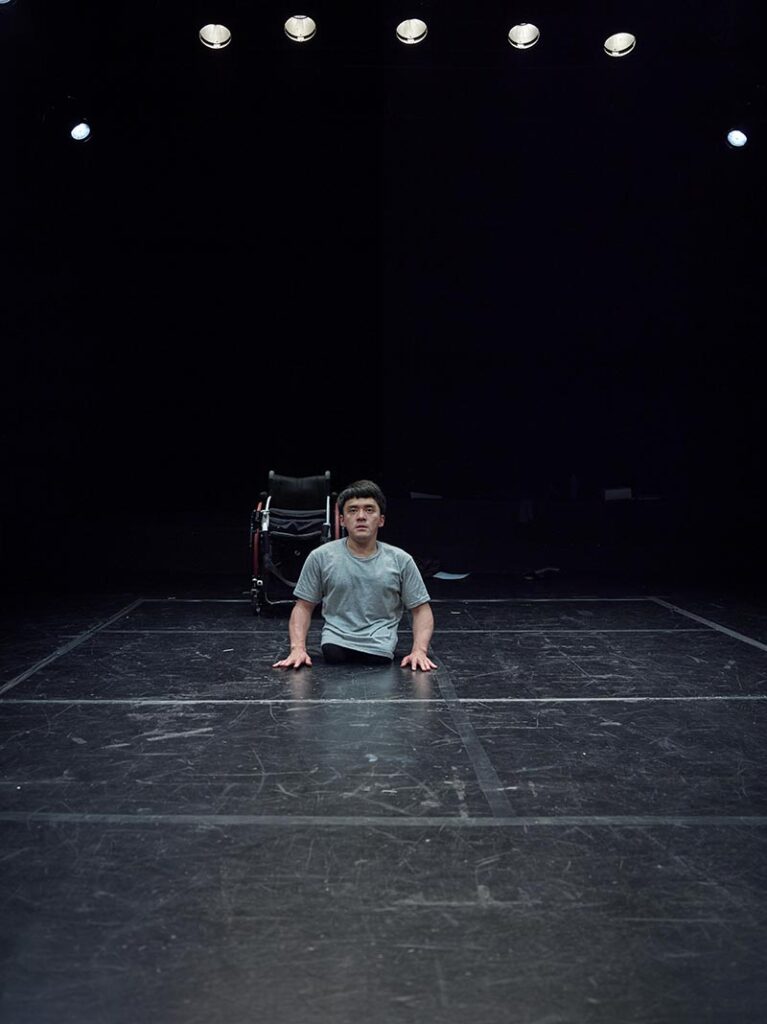
2021년도 작품 무용수-되기를 창작하게 되신 계기와 창작 과정에 대해 설명해주실 수 있나요?
주제의 측면에서 말한다면, 무용수-되기는 현대무용이 1960년대 소위 ‘민주주의의 몸’을 외쳤으면서도, 정작 장애를 가진 몸은 오랫동안 이 영역에서 부재했다는 점에서 출발합니다.
1960년대 현대 무용을 혁신했다고 불리는 현대 무용가인 이본 라이너의 작품 트리오 에이를 공연의 시작점으로 잡은 이유입니다. 트리오 에이를 제 몸에 맞춰 ‘번역’했고, 또 비장애인 무용수와 같이 출 수 있게끔 한 번 더 번역을 했습니다.
이본 라이너가 일상적인 움직임을 보여주는 영상이 있습니다. 그걸 사실은 제가 따라할 수 없죠. 하지만 휠체어를 타고 할 수 있는 움직임으로, 저희는 ‘번역’이라고 표현을 하는데, 번역해서 연습을 했어요. 한 번은 제 몸에 맞춘 움직임으로 번역을 하고, 이렇게 한 번 번역된 움직임을 비장애인 댄서가 출 수 있게 다시 한 번 번역하는 과정을 거쳤어요.
무용에는 세 가지 시퀀스가 있어요. 트리오 에이가 있고, 중간에 짧은 솔로가 있고, 마지막에 바닥에서 하는 장면이 있어요. 그 장면들을 쭉 발전시키면서 두 가지 인상적이었던 것이 있어요. 한 가지는 바닥에서 하는 장면 같은 경우, 이전 작품 사랑과 우정에서의 차별금지 및 권리구제에 관한 법률에서는 처음 휠체어에서 내려왔다고 했잖아요, 이번 무대에서는 훨씬 더 여러가지 즉흥 움직임을 시도할 수 있었어요. 바닥에서 저의 신체로 가능한 다양한 움직임들을 많이 찾는 과정이 있었기 때문에, 바닥 움직임의 가능성을 찾는 과정이었어요. 트리오 에이 시퀀스에서는 저희가 만든 정확한 안무에 따라서 아주 섬세하게 움직임을 연습하는 시간이었고, 그것도 저에게는 매우 즐거웠습니다.
사랑과 우정에서의 차별금지 및 권리구제에 관한 법률에서는 안무가 중요하다기보다는 훨씬 더 충동적으로 휠체어에서 내려가고 관객을 만나고 이런 게 중요했다면, 무용수-되기 공연에서는 바닥 장면도 그렇고 트리오 에이도 그렇고 저의 몸이 가능한 움직임을 잘 찾고, 그것들을 잘 쌓아서, 잘 조립해서 연습을 철저하게 해서 하는, 좀 더 전통적인 댄스 퍼포먼스의 작업 방식을 통해서 제가 할 수 있는 걸 찾았던 것 같아요. 그게 저한테 되게 재밌었어요.
선생님께서는 키아다 심포지엄에서 다음과 같은 질문을 제시해 주셨어요: ‘비장애’ 미학에 집착하지 않으면서 어떻게 우리의 몸들을 공연에 통합할 수 있는가? 이 질문에 대한 생각을 조금 더 나눠주실 수 있나요? – 선생님이 생각하시기에 ‘비장애’ 미학이라는 것은 무엇인가요? 또 그것이 장애인 무용가들을 통합하는 것에 있어 어떤 문제점들을 발생시키나요?
비장애미학이란 말은 아주 넓은 의미를 가질 것 같습니다. 기본적으로 특정한 테크닉을 지향하는 것일 수도 있고, 서양무용의 발레에서부터 내려온, 수직적이고 상승지향적인 충동도 포함됩니다. 그 중에도 저는 ‘몸’에 대한 인식의 측면에서 비장애미학을 말했습니다. 장애가 없기 때문에 팔다리의 움직임이 더 원활하고, 더 대칭적이고, 더 기능적인 움직임에 대한 열망 같은 것이지요. 비장애인의 몸들이 무대에서 춤을 추면, 거기서 오는 어떤 아름다움이나 쾌감이 있죠. 장애가 있는 신체는 그것을 할 수 없는 경우가 많죠. 이건 한국의 다른 무용수들이 아니라 제 개인적인 이야기인데, 제가 그런 것에 대한 어떤 지향이나 집착을 잘 버리지 못하는 것 같아요. 그것이 제 자신의 몸도 그렇고 다른 장애인 무용수의 몸도 그렇고, 그 사람들을 무용 씬에 통합하는 데에 방해가 되고 있는 것 같아요.
간단하게 말해서, 저는 여전히 중증 장애를 가진 몸들에서 미적인 순간들을 포착하는 것에 때로 어려움을 겪어요. 발견하려고 노력을 하는데, 그 순간을 만나는 건 어려워요. 가령 워크숍에서 장애를 가진 발레 무용수나 뇌성마비를 가진 공연가를 만나요. 늘 그런 다른 몸들이 갖고 있는 고유한 아름다움과 미적 가치를 찾으려고 시도하지만 실패해요. 그러한 제 인식을 깨고 싶지만 어려워요. 이게 제가 장애인 무용수/안무가로서 가진 한계인 것 같아요.
선생님께서도 개인적으로 그렇게 장애를 갖고 있는 무용수들에게서 비장애 무용수와 동등한 미적 가치를 발견하는 것에 어려움을 겪고 있다면, 주류 무용을 관람하는 관객들로 하여금 어떻게 장애 무용을 감상하도록 할 수 있을까요?
각자의 몸에서 발견되는 고유한 미적 가치나 아름다움을 발견하고 포착하는 데 저는 실패하고 있고, 그래서 이 고민을 이야기했던 거에요. 그런데, 저는 실패하고 있지만, 제가 한국에서 만난 많은 관객들이 제가 생각했던 것보다는 다양한 몸이 가지고 있는 춤의 가치와 아름다움을 발견하는 사람들이 분명히 있었어요. 그걸 제가 공연하면서 만났던 것 같아요. 그런 관객들이 외국에도 있을 거라고 생각해요. 저는 실패하지만 그런 관객들이 분명히 있기 때문에 저는 장애 무용수들이 주류 무용씬에 통합될 수 있는 가능성이 있다는 믿음을 갖고 있어요.
장애를 부정하지 않으면서 비장애를 모방하지 않는 미적 가치를 어떻게 발전시킬 수 있을까요?
무용씬이 마주한 도전이어서 굉장히 어려운 것이라고 생각해요. 저도 정확한 답은 모르지만 일단 제 경험을 바탕으로 생각하고 있는 것은, 장애인 무용수들이 비장애인 무용수의 움직임을 그냥 단순히 따라하는 것이 아니고, 자기만의 움직임과 몸의 특성을 가지고 좋은 작업을 만들기 위해서는 그 무용수의 몸이 굉장히 선명해지는 게 중요한 것 같아요. 그 몸이 아주 선명해지면 선명해질수록 그 움직임이나 형태가 주는 미적인 힘은 덜 중요해지는 것 같아요. (로댕의 조각상을 보고 굉장한 선명함에 대해 노래한 릴케의 시 ‘고대 아폴로 토르소’를 생각해볼 수 있죠.)
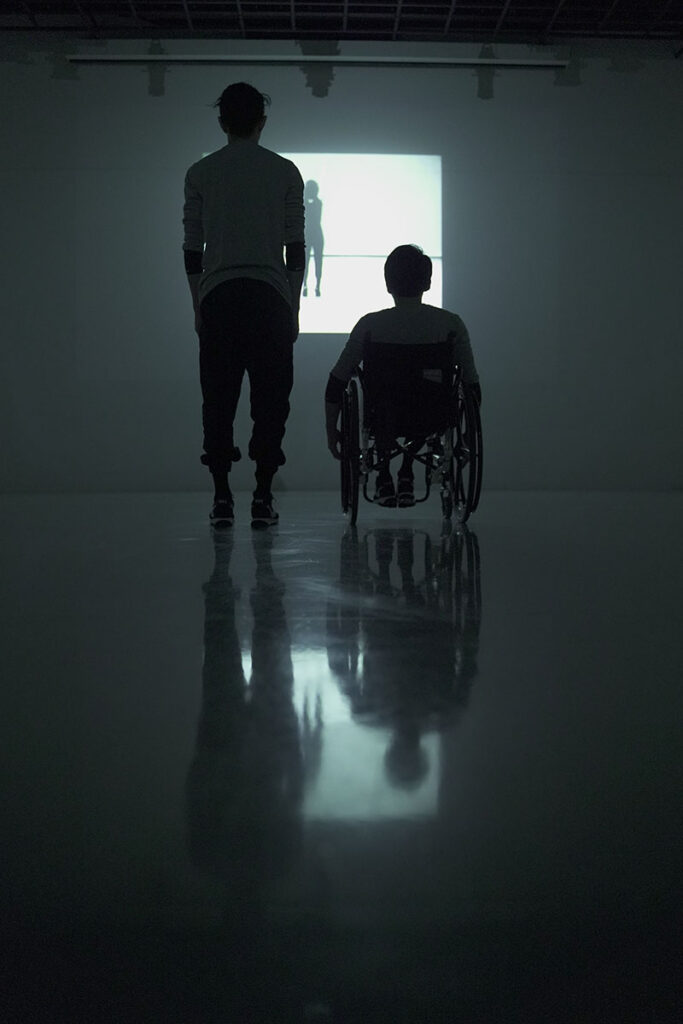
심포지엄에서 짚어 주셨던 또 다른 질문은: 권리와 무용은 어떤 관계를 갖는가? 였어요. 법학 학위를 갖고 계신 걸로 알고 있는데, 선생님이 생각하시기에 법은 어떻게 무용과 맞닿아 있나요? 법에 대한 이해와 장애에 대한 예술적 이해가 서로 어떤 영향을 주나요?
사회적인 차원에서는 어떤 법과 제도와 권리들을 잘 만들어야 더 다양한 몸을 가진 사람들이 창의적인 활동에 잘 참여할 수 있을까 이런 주제가 있을 것 같아요. 법은 무용과 비슷해요. 둘 사이에 유사한 점이 있어요: “이렇게 움직여라” 또는 “이게 더 나을 것이다”라고 명령하죠. 구체적인 안무가 존재할 때, 오히려 특히 장애인들의 몸 같은 이런 다양한, 안무화되기 어려운 몸을 가진 사람들은, 더 좋은 자기만의 움직임을 하기가 어려울 수도 있어요.
거칠게 말해서, 안무를 법적 제도로 이해하고, 무용을 민주적인 정치 행위로 이해할 수 있어요. 장애를 가진 몸들의 입장에서는 이 두 가지 문제가 깊게 엮여있어요. 안무를 만드는 건 법을 만드는 것과 비슷해요. 때로는 법이 싫을 때가 있어요. 안무를 짜기가 싫고 즉흥적으로 움직이고 싶어요. 하지만 그렇다고 즉흥이 언제나 좋냐고 물으면 그렇지 않아요. 때로는 즉흥적인 움직임은 제가 좋은 공연가가 되는 것을 가로막아요.
어떤 법 규범과 명령 체계를 만드는 것이 다양한 사람들의 자유를 증진시킬 수 있는가? 라는 정치적 질문이에요. 이 정치적 질문은 안무가 필요한지, 필요하다면 어떻게 해야되는지, 그 안무에 맞춰 춤을 춰야 되는 다양한 몸을 가진 사람들의 예술적 문제이기도 합니다.
한국에는 장애인 무용가들을 위한 기회가 충분하다고 생각하시나요? 그렇지 않다면, 해결되었으면 하는 부분이나 개선되었으면 하는 분야는 무엇인가요?
모든 해외 안무가들이 한국어를 할 수 있게 되거나, 한국의 모든 장애인 무용수들이 영어나 다른 외국어를 할 수 있었으면 좋겠어요. 협업은 장애 무용에서 더더욱 중요해요. 한국이 지리적으로나 언어적으로 고립된 사회라는 점이 한계를 만들어요. 한국에 뛰어난 예술가들을 알지만, 이 분들이 해외의 예술가들을 만날 기회는 드물어요. 한국 예술가들이 미국과 유럽, 아시아의 공연가들과 협력할 수 있는 기회를 더 만들고 싶어요.
선생님의 다음 계획은 무엇인가요? 미래에 하실 공연이나 프로젝트 중에 공유하고 싶으신 것이 있나요?
장애와 공연예술을 다룬 책을 쓰고 있고, 올 여름쯤 출간되리라 기대합니다. 여름에는 무용수-되기 공연을 하기 위해서 크로아티아와 슬로베니아를 방문할 계획입니다. 두 국가와 네 도시의 페스티벌에 참여할 것입니다.
~~

2 Responses to “The Relationship between Rights and Dance”
Absolutely, thanks Jimmy:)
I appreciate having Read this interview..if broadened me even more hearing the ♥ Heart of this Artist.
Comments are closed.